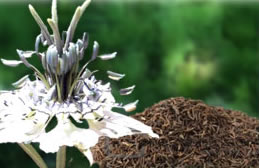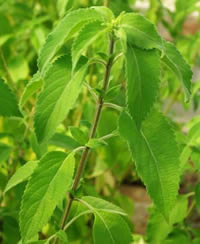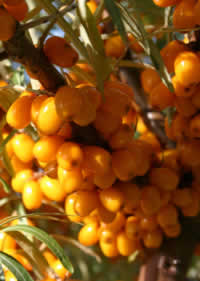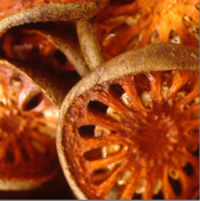Radioprotective Herbs |
m | ||||||||||||||||||||||||
Posted to Subscribers on 17 March 2011 |
|||||||||||||||||||||||||
|
|
Dear Subscribers, Before going into endless details, let me begin with a rough attempt to explain how an herb might be classified as radioprotective. Gruesome as this might be for some people, what is different about these studies and conventional attempts to assess merit is that studies are in vivo, not in petri dishes. Most of you do not really want to know how the studies are conducted, but if we start more or less at the beginning, we have to go to the sites of the A bomb blasts that occurred over Hiroshima and Nagasaki in August 1945. As we know from our history, Japan surrendered on August 15th and studies of what happened began almost immediately. Though what was learned remains relevant, there are considerable differences between nuclear bombs and nuclear powers plants. First of all, the bombs are detonated in the air before reaching the ground. Shamefully, the bombing of Hiroshima took place about 1900 ft. above the Shima Surgical Center. The bomb was an "inefficient" fission weapon made of uranium-235. The blast was equivalent to a simply staggering amount of TNT but only about one square mile was completely demolished, this along with 90% of the doctors and 93% of the nurses in the city. There were a small number of survivors within that one square mile, most of them were in buildings designed to withstand earthquake damage. That's the thumbnail sketch. Analysis of deaths and survival tried to take as many factors into account as possible. Eventually, of course, this included diet and attempts to assign particular outcomes to differences in diet. Not surprisingly, Japanese people eat Japanese food so a lot of attention went into miso soup and seaweed. If the bomb had been dropped somewhere else, God forbid, the articles of food studied would have been different. All I am saying is that preliminary studies of radioprotective food were conducted in Japan and it's 100% obvious that the pressure to advance this knowledge will be enormous in the times to come. Meanwhile, the U.S. continued its nuclear testing, mainly in Nevada, in the 1950s but also in the South Pacific (through the 60s). All radioactive cesium is a by-product of nuclear testing or nuclear accidents, including a few medical and other technological devices that were disposed of improperly. Radioactive cesium does not occur naturally. Even if the reactor relies on uranium or plutonium, a certain amount of secondary radioactive materials are produced during the fission process, most of which have very short half lives, sometimes seconds. How the radioactive material travels once released depends on heat, weather, wind, and quite a few more factors that make predictions extremely difficult, but the bottom line is that all immediate fatalities in Chernobyl occurred as a result of completely faulty safety procedures and failure to adhere to recommended protocols. What we learned is that radioactive iodine did not travel very far and its effects did not last long. Nearly all the longer-term consequences of the worst nuclear disaster in history are attributed to cesium-137. It traveled as far as the British Isles where farms are still contaminated. The conclusion is that while some people who were part of the relief efforts in Chernobyl had horrific exposures to multiple types of radioactive materials, the figures for death from these exposures suggest that 57 people died as a direct consequence of relatively early presence at the Chernobyl disaster site. Of those who took the recommended dose of Ginkgo biloba, there were no recorded deaths. We have to ask why, but to do so, we have to look at two more types of irradiation. The first is medical irradiation for diagnostic or treatment purposes and the second is irradiation done in research contexts. If radiation is used to view the interior of the body, the ends have to justify the means but using radioprotective food and herbs is entirely permissible since these do not affect the imaging. In the case of treatment, usually based on cobalt but sometimes iodine or cesium, patients are counseled not to interfere with the desired consequences of irradiation by avoiding non-radioactive substances of the same type. In short, do not block the effects of radioactive iodine by taking iodine in a more harmless form. So we do not learn much until we get to the laboratory trials. These are beyond horrific, but what they do is divide the test animals into groups, some of which are given substances in various forms and dosages and some of which are denied any protection. The substance is regarded as radioprotective if the irradiation which kills other animals spares the lives of those that were dosed. Over the years, I have read a lot of such studies revolving around Chyawanprash. It is regarded as a superb As a result of the necessities arising from the Fukushima disaster, I have burned the midnight oil and added quite a few more successful studies to the list. However, before saying too much more, I want to repeat a few points so all remains clear. First, while there are some similarities between full body irradiation and a nuclear disaster, the two are not the same much less similar to being at ground zero of a nuclear explosion. Secondly, there are variations in the types of radiation and hence differing abilities to manage the effects. There are also enough common denominators to make the studies relevant.
Interim Summary The full consequences of the Fukushima Nuclear Disaster will not be known for years to come. In all probability, there will be very few immediate deaths. Everyone at a distance from the site will have time to overcome the risks and avert both cancer and death, but the environmental impact will be serious. This also is hard to predict but there will be fallout and it will impact both land and water and therefore the environment will suffer yet one more assault. This is something the whole world needs to consider because what our generation is leaving to future generations is much more than a mountain of absurd debt but also a Planet that has been pillaged, plundered, and polluted almost beyond recognition. It's hard to say how many more reminders we need. Last year there was the Gulf of Mexico disaster and not even a year later a nuclear disaster. Surely it is time to allow free energy? Personally, I am not worried about the fallout on my own health, but I am worried about politics, power, spin, and their impact on the Planet. If I am honest, I have to say I have not figured out my own environmental strategies. Yesterday was a little warmer than it has been. Today, three beautiful white crocus flowers appeared along with some yellow primroses. It feels like a time of rebirth and renewal, not disaster. Yet, the predictions are that the plume will hit the West Coast tomorrow. It's hard to believe, hard to accept. I don't want anything to suffer, not one plant, animal, or person. Many blessings, Ingrid
Copyright by Ingrid Naiman 2011
Radiation: the Fukushima Nuclear Hazards || Nuclear Power
|
||||||||||||||||||||||||
Home || Contact Us |
|||||||||||||||||||||||||
No content on any of the pages of this web site may be reproduced without written permission of Ingrid Naiman and Seventh Ray Press, publisher of this site. |
|||||||||||||||||||||||||
|
|||||||||||||||||||||||||
 antioxidant and it is radioprotective. I was also aware that Nigella sativa oil is radioprotective, but a few days ago, I found a study of the alcoholic extract of black cumin seed. It had as much protective power as the oil, something that very much surprised me since the oil would have been expected to confer much more protection for the lipid structures.
antioxidant and it is radioprotective. I was also aware that Nigella sativa oil is radioprotective, but a few days ago, I found a study of the alcoholic extract of black cumin seed. It had as much protective power as the oil, something that very much surprised me since the oil would have been expected to confer much more protection for the lipid structures.





